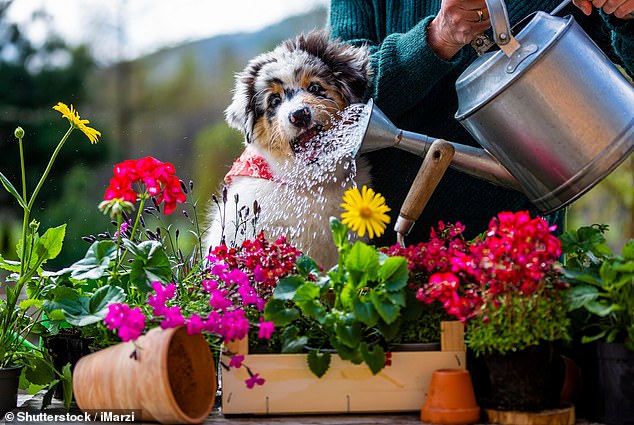Table of Contents
The garden is a great place for pets to relax and exercise; However, research has revealed that around 8 million dogs in the UK could be exposed to poisonous garden plants.
Dr Lily Richards has revealed what Brits should avoid planting in the garden if you’re a proud pet owner and suggested safe alternatives for your vegetable patch.
From identifying toxic plants in gardens to creating pet-only areas, their tips help homeowners strike a balance between a beautiful, flourishing garden and the all-important safety of pets.
To protect all pets from the potential dangers lurking in your garden, six tips from a qualified veterinarian It ranges from being aware of the type of plants you can grow to avoiding certain herbicides.
Dangerous toxic plants
Are there hidden dangers lurking in your garden? While certain plants look pretty, they could be toxic to pets (file image)
If you have pets, it is essential that you choose the right plants for your garden.
Veterinarian Lily Richards said: ‘Some examples of commonly grown toxic garden plants and additions to vegetable gardens include onions, garlic, chives, oregano, leeks, daffodils, lilies and rhododendrons.
“It is always best, before planting, to check the suitability of plants and vegetables around pets if you plan to share the space.”
One surprising addition to vegetable gardens that could put your pets at risk are tomatoes.
While the ripe fruit itself is safe, the stems, leaves, or unripe green tomatoes contain glycoalkaloids called solanine and tomatine, which are toxic to both cats and dogs.
Owners should always be careful when growing tomatoes around pets.
And if you have a pet that likes to dig, you need to be even more careful about what you grow in the garden, because the plant bulbs are often the most toxic.
Lily recommends opting for pet-friendly plants, fruits and vegetables in your garden, such as dill, calendula flowers, magnolia bushes, rosemary, fennel, basil or carrots.
You can also use hanging planters, raised beds, or large containers to help discourage pets from accessing potentially dangerous plants.
Protect your vegetables
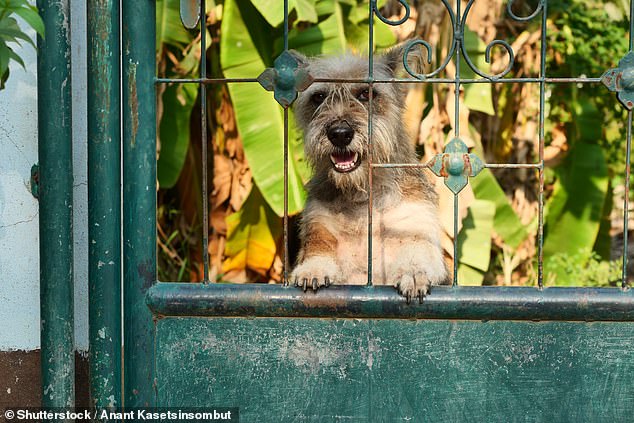
A brown furry dog standing behind a green fence with a green plant in the background (stock image). Dr. Lily tells pet owners to avoid using chemicals around their plants and, if you can, fence off pet-free areas.
If you have a garden, you must protect both your vegetables and your pet.
Lily said: ‘Consider raised beds or hanging baskets to keep your pets and vegetables safe.
‘Avoid chemicals on or around your plants, such as slug pellets, insecticides, herbicides or growth products.
‘You can also try organic alternatives and compost as a natural and safer alternative.’
If possible, you should also fence pet-free areas, but be sure to choose the right fence for your pet.
The expert explained: ‘You have to take into account the types of fences for each species, as rabbits and guinea pigs have different requirements to keep them safe than dogs.’
Any composting area should also be fenced as it can be highly toxic to dogs and other animals due to fungi growing on the plant or decomposing food material.
You should also avoid using foods that are toxic to pets in your compost pile, such as onions, garlic, coffee grounds, and chocolate.
The vet also recommends monitoring or leashing your pets when they are in the yard to make sure they don’t enter pet-free areas, which is especially important when introducing new pets to the yard.
Opt for paw-safe materials
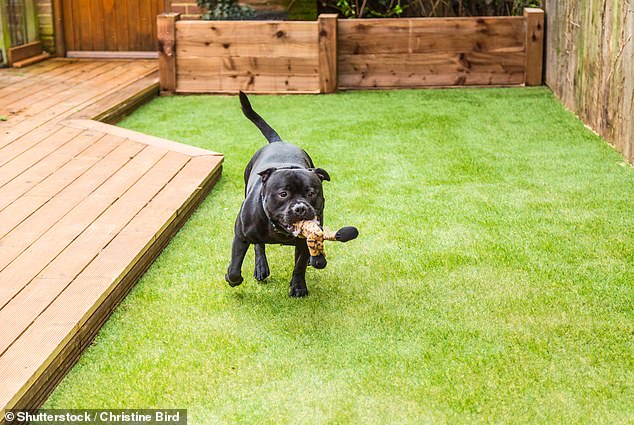
File image of a black Staffordshire bull terrier dog running and playing on artificial grass in a garden, the preferred surface for a dog
As the weather warms, so do certain surfaces in the yard, and hot pavers and asphalt can quickly pose a threat of burns to your pet’s paws during hot weather.
Some lower quality artificial grasses can also be dangerous for pets, as the synthetic material can heat up to 30 degrees hotter than real grass in the sun.
The quality and brand of your artificial grass plays a role, so if you prefer fake grass, look for a high-quality, pet-friendly option.
If you are concerned that surfaces are too hot, always check them with the back of your hand before allowing your pet’s paws to explore.
A good rule among them is: if it’s too hot for your hand, it’s also too hot for their delicate paws.
For pets, the ideal surfaces in your garden are real grass and wooden decking. It’s also great to have trees and shrubs that provide plenty of shade in the summer.
Create a pet play area and digging hole
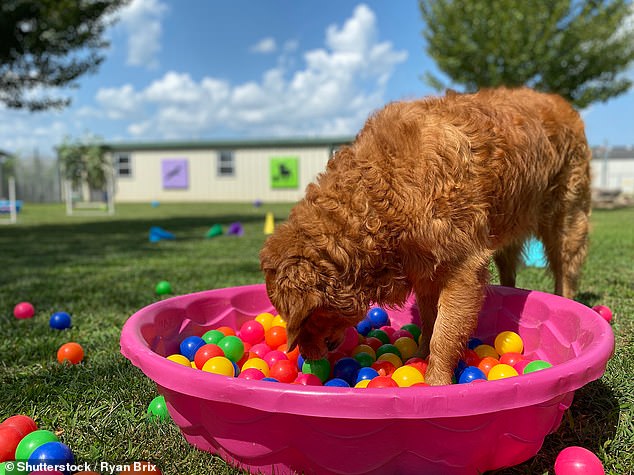
File image of a golden retriever dog playing in a pool of colored balls. Qualified vet explains how creating a dedicated play area where your pet can thrive will stimulate and preoccupy them
Digging is a natural behavior for dogs.
If your pet likes to dig and you’re worried about them ruining your yard, consider creating a pet-only play area with all their favorite toys and a sandbox.
You can also fill a paddling pool for your pup to cool off in the summer.
Creating a dedicated play area where your pet can thrive will stimulate and preoccupy them, preventing them from damaging other parts of the garden.
Play areas also provide essential enrichment for dogs, particularly high-energy dogs, and can reduce boredom and the likelihood of developing behavioral problems.
Choose Lawn and Patio Treatments Carefully
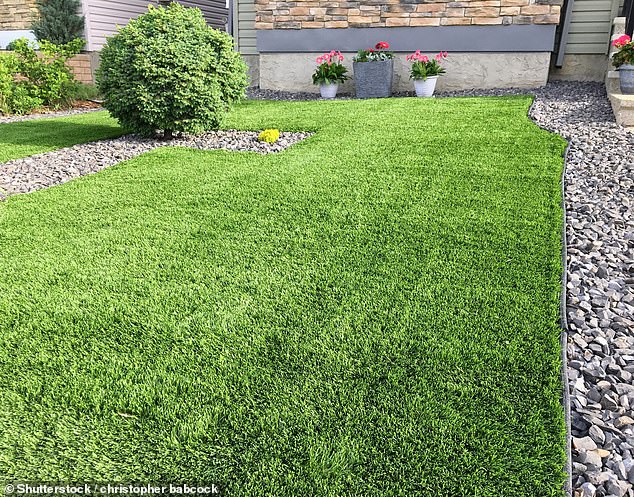
Stock image of a beautiful artificial grass in the front yard with pretty flowers and bushes surrounding it. While this may seem aesthetic, be wary of low-quality artificial grass that heats up faster as you may risk burning your pet.
“Carefully consider herbicides and lawn or yard treatment products,” cautioned veterinarian Lily Richards, as many herbicides are not safe for pets.
She explained: ‘Pets that walk across treated areas are likely to transfer the product to their feet and wipe it off, then ingest it.
This could cause serious toxicities and illnesses in pets.
Consider natural or pet-safe products, or if you must use potentially harmful products, make sure your pet does not have access to the garden until the product residue is gone.
This is especially crucial when considering herbivorous pets such as rabbits or guinea pigs: it is never appropriate to use chemicals in areas where they can graze.”
If you suspect your pet has consumed something harmful, take him to the vet immediately.
Common signs of poisoning include diarrhea, drooling, vomiting, and tremors. If you can, carry a container with the product your pet ingested so the veterinarian can better determine how to treat your pet.
Beware of wildlife
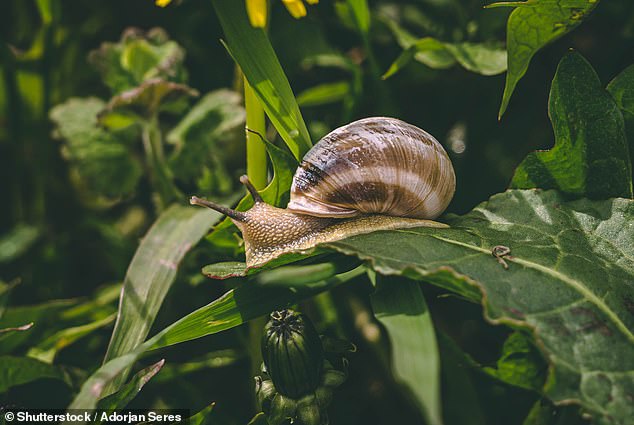
We all know that certain wild animals can be harmful to our pets, but did you know that removing them can also be problematic? The photo above is a stock image of a snail, which can cause lungworm disease in your pets.
Some wild garden animals can be dangerous to pets, but wildlife removal products can also pose a risk.
“Gardens tend to invite nature and wildlife, so keep an eye out for slugs and snails,” the vet said.
‘These creatures can carry parasites and infectious diseases, such as lungworm, which can cause serious illness in your pets.
Avoid using non-organic slug pellets to keep these critters at bay, as they are also toxic to your pets.
The yard can also be a hotbed for fleas and ticks, especially if it has tall grass, but your pet will remain safe with proper vet-approved preventive measures.
Talk to your veterinarian about the most appropriate parasite protection for your cat or dog and check your pet’s coat after being outdoors.

